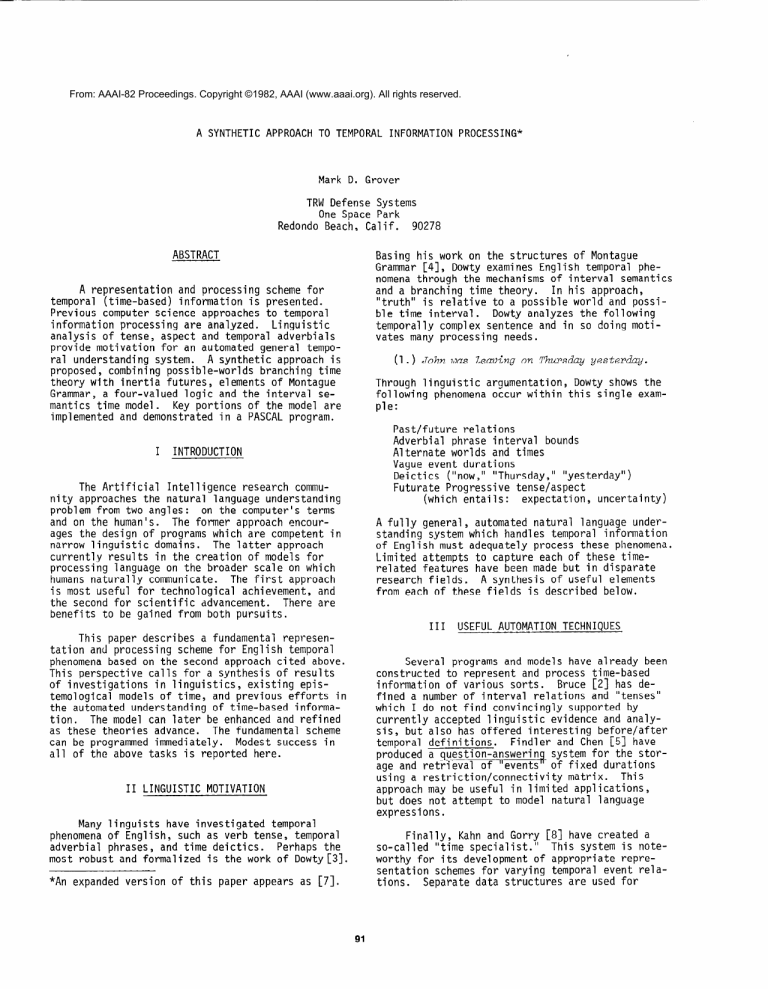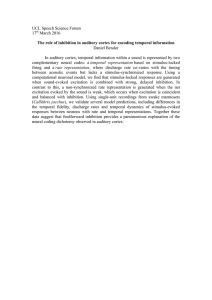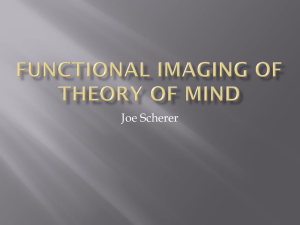INFORMATION PROCESSING*
advertisement

From: AAAI-82 Proceedings. Copyright ©1982, AAAI (www.aaai.org). All rights reserved. A SYNTHETIC APPROACH TO TEMPORAL Mark INFORMATION PROCESSING* D. Grover TRW Defense Systems One Space Park Redondo Beach, Calif. 90278 ABSTRACT Basing his work on the structures of Montague Grammar [4], Dowty examines English temporal phenomena through the mechanisms of interval semantics In his approach, and a branching time theory. "truth" is relative to a possible world and possiDowty analyzes the following ble time interval. temporally complex sentence and in so doing motivates many processing needs. A representation and processing scheme for temporal (time-based) information is presented. Previous computer science approaches to temporal information processing are analyzed. Linguistic analysis of tense, aspect and temporal adverbials provide motivation for an automated general temporal understanding system. A synthetic approach is proposed, combining possible-worlds branching time theory with inertia futures, elements of Montague Grammar, a four-valued logic and the interval semantics time model. Key portions of the model are implemented and demonstrated in a PASCAL program. I (1.) John was leaving Through linguistic argumentation, following phenomena occur within ple: INTRODUCTION A fully general, automated natural language understanding system which handles temporal information of English must adequately process these phenomena. Limited attempts to capture each of these timerelated features have been made but in disparate A synthesis of useful elements research fields. from each of these fields is described below. III This paper describes a fundamental representation and processing scheme for English temporal phenomena based on the second approach cited above. This perspective calls for a synthesis of results of investigations in linguistics, existing epistemological models of time, and previous efforts in the automated understanding of time-based information. The model can later be enhanced and refined as these theories advance. The fundamental scheme can be programmed immediately. Modest success in all of the above tasks is reported here. LINGUISTIC MOTIVATION version of this paper appears USEFUL AUTOMATION TECHNIQUES Several programs and models have already been constructed to represent and process time-based Bruce [2] has deinformation of various sorts. fined a number of interval relations and "tenses" which I do not find convincingly supported by currently accepted linguistic evidence and analysis, but also has offered interesting before/after Findler and Chen [5] have temporal definitions. produced a question-answering system for the storage and retrieval of "events" of fixed durations This using a restriction/connectivity matrix. approach may be useful in limited applications, but does not attempt to model natural language expressions. Many linguists have investigated temporal phenomena of English, such as verb tense, temporal Perhaps the adverbial phrases, and time deictics. most robust and formalized is the work of Dowty[3]. *An expanded Dowty shows the this single exam- Past/future relations Adverbial phrase interval bounds Alternate worlds and times Vague event durations Deictics ("now," "Thursday," "yesterday") Futurate Progressive tense/aspect expectation, uncertainty) (which entails: The Artificial Intelligence research community approaches the natural language understanding problem from two angles: on the computer's terms and on the human's. The former approach encourages the design of programs which are competent in narrow linguistic domains. The latter approach currently results in the creation of models for processing language on the broader scale on which humans naturally communicate. The first approach is most useful for technological achievement, and the second for scientific advancement. There are benefits to be gained from both pursuits. II on Thuxsday yesterday. Finally, Kahn and Gorry [8] have created a so-called "time specialist." This system is noteworthy for its development of appropriate representation schemes for varying temporal event relations. Separate data structures are used for as [7]. 91 events linked by dates, by undated temporal order and by reference events. For the first time, events with fuzzy bounds are represented. However, it is open to question how to use three separate knowledge representations concurrently. Kahn and Gorry acknowledge that their effort to produce a temporal idiot savant ignores syntactic and semantic time-based knowledge. IV SYNTHESIS AND The assumed input is a sentence of English which can be parsed by Montague Semantics methods as modified by Dowty's translations rules. Friedman [6] offers such a parsing scheme, although it is presumed that Dowty's tense rules could be added to her work. Friedman also describes several simplification techniques to reduce the result of translation into a more extensional formula. This formula is then reduced further to a procedural form, i.e., LISP-11 ke notation in preorder. For example, Dowty's translation for sentence (1.) is IMPLEMENTATION Since the understanding of time is intimately related to our understanding of the nature of the temporal events we experience, a more fruitful (longer-term) approach is one in which the processing scheme is based on the information and operators shown to exist by linguistic analysis. This is the second approach discussed in the Introduction--basing automated capabilities on natural (human) linguistic capabilities. (2.) V tl [ PAST(t, PROG C_ yesterday'AAT(t,, [ V t2 [ PAST(t2)AAT(t2, termined' (- V tS [ t3 C_ Thursday'A leave’(j)) FUT(t3)r.AT(t3, where V means A means "there exists" PROG The procedural Figure 2. or "for some" operator is the progressive form I>) I I) 3 "and" n is the intension Using this paradigm, a model of an automated general temporal understander was constructed. The model centers around those processes and information schemes motivated by Dowty's linguistic analysis and by branching time theory. The top-level organization appears as Figure 1. prede- of this operator statement appears as ( POSIT I: FORSOME TM~ (AND (PAST TM~) (CONTAINED-IN (AT ml TM~ [ 01 1 ) YESTERDAY) 11) I SYNTAX,,TREE(S) Direct I Translation where ~$1 is [ PROG ( FORSOME TM2 Postulates 6 Lexical I (TENSE) LOGICAL I where e2 is [ PREDETERMINED-INT (FORSOME j where b3 is [ AND TM3 THURSDAY) ~~~:~%x? )rENIrrdering (FUTURE TH3) (AT TY~ (LEAVE-JOHN)) John was leaving pointers > _Requests for mre info CENTER I FIGURE yesterday. Statements are processed by storing or moving instances of generic events (written in "Cambridge Polish") on nodes in a directed world/time graph In contrast to an outward-branchwithout cycles. ing tree structure, the network allows the system to combine portions of histories which are 1 Temporal Understanding on Thursday The input is assumed to be a statement (a belief to be posited, i.e., stored) or a question (a belief to be interrogated, i.e., searched for). Of course, system commands can also appear in the Such commands are primarily deictic defiinput. ni tions to be stored in contextual memory, but also are for attention management and I/O control. conflict A General Form of Time unit heuristics <Inertial guidance ri$$zJ 2 This form is the input to the implemented portion of the model, encompassing those processes below the dashed line of Figure 1. Current Events (descriptions) Event Graph (World/Time) Clock ] heuristics Procedural adjustments [ +3 ] )] I (CONTAINED-IN FIGURE . TM3 (to other processors) Bimplification I ESSENTIAL SEMANTIC Report of actions (PAST TM2) (ATTM2[: 02 1 1)) 1 Y I . . (AND System 92 "identical" because no distinguishing occurrences are known. Although extensively defined in [7], some operators and functions are briefly described here: quantified (local) A sample Figure 3. FORESOME: existential quantification over time. Produces search interval bounds nested to the depth of quantification. time situation interval variable in graph form appears Q Beginn PROG: creates alternate futures (uncertainty) where an event does not "happen" in all branches, but does in inertia futures'(Dowty's term). Inertia worlds'"expected." Expectation is mana ed by a scripted event series' (a Za Schank 1.00 AT: simple, "primitive" specific world and time. event link occurrence B It has been told both about non-occurrence of the event possible worlds). Z It has no question. (zero) told that the event Sample information relevant 3 Situation The implemented portion of the model was accomplished in a 3100-line PASCAL program which The includes 65 small procedures and seven files. complete text of the program and a detailed demonstration run appears as appendices to [7]. A brief example of the four resultant belief values for elementary question-answering operations appears in Figure 4. Answer 1nput/Meaniqq does the occurrence (in different ...................... FIGURE occurs given the worlds and time considered in the question. has been Build-house-Vary Not-sleep-John Prepare-food-cook Throw-up-John ,,,I,,F+99.999.................................. Question-answering is accomplished by a fourvalued belief logic [1, 91. For coherent questions the answers can be: The system not occur. sep-John Not-pay-bill-John Tables of deictic variables (intervals and moments) are kept in contextual memory. These definitions can be changed as the speaker's time They provide links between the event changes. graph and the speaker's world. F Sleep-John Leave-Nary in a Additional information stored in the graph allows further processing shown useful by other investigators. For instance, reference counts for each event are stored. This can be used not only for garbage collection, but for memory decay modelling. That is, if a hypothetical past event is considered once, but never again, one can cause that possible event to fade from memory. (See also Schank [op.&t.]). Related to this phenomenon is the allowance of deviant, but expected, events in the script. Further, each node contains an inertia ratio which is used as a rough expectation rnz Thus, a search across worlds at a given moment will be ordered by the amount of scripted information which appears. No attempt was made to consider rapidly changing contexts. The event intervals Y3 ........ o.M) ......I Eat-food-John Bring-food-waiter in a Tn3~777.7 T ng-of-vmrld t ~=500.5 .....*....... u4 0 d d. initial in ~~.O*.......................................... 0% conjoins a heuristically ordered list of AND: temporal interval restrictions including deictics, PAST and FUTURE (single bounds) and specific moments. PREDETERHINED: establishes chain of scripted events. bounds. With "now" = TM2: and (9 (FORSOME T (AT T PAY-BILL-JOHN))) Does John pay the bill? F (Q (FORSOME T (AT T LEAVE-JOHN))) Does John leave? Z (Q (FORSOME T (AT T SLEEP-JOHN))) Doee John sleep? to the but -- Search and storage/retrieval is accomplished by narrowing down temporal intervals by layered and These bounds are established stacked time bounds. by conjoined deictic and moment references, as well as before/after relations inherited from higher * * with "now" = TM4: FIGURE Sample 93 Program 4 Response B T Notice that as "now" changes, so does the answer the last question. Such non-monotonicity is a natural and expected result. to International Conference on Computational Linguistics. University of Bergen, Norway. August, 1978. The model, while certainly incomplete, allows further experimentation with such phenomena as possible translations of temporal adverbial phrases As workers such as Dowty (e.g., since yesterday). provide similar Montague-based definitions, this model can act as a vehicle for examining computational implications. Many problematical cases remain. V c71 Grover, Mark D. "A synthetic approach to the representation and processing of temporal phe(Northnomena of English." Ph.D. dissertation. western University.) University Microfilms. Ann Arbor, Michigan. June, 1982. 181 Kahn, K. and G. A. Gorry. "Mechanizing temporal knowledge." Artificial Intelligence 9:87-108. August, 1977. VI CONCLUSIONS Automated understanders of natural language phenomena can be based on processes illuminated by linguists, using organizing schemes of epistemologists, and representation and processing techniques of computer scientists. Such a synthesis allows cautious expansion from a reasonable foundation, Features of the model provide mechanisms to experiment with expectation and script construction, memory management (methods of "forgetting"), deixis, unusual tense and aspect combinations, multiple-valued logic, and various "possible worlds" phenomena (e.g., contrafactives and epistemic modalities). II1 01Schank, tive This methodology should also be reassuring to researchers moving from natural language to programs through general model design rather than by attempting to capture only narrow temporal phenomena or by ignoring useful results in linguistics and epistemology. REFERENCES Cl1 Belnap, Nuel D., Jr. "A useful four-valued logic." In M. Dunn and G. Epstein, eds., MODERN USES OF MULTIPLE-VALUED LOGIC. D. Reidel Publishing Co. Dordrecht, Holland. Pages 5-37. 1977. PI Bruce, Bertram C. "A model for temporal reference and its application in a Q/A program." Artificial Intelligence 3:1-25. 1972. [31 Dowty, David R. WORD MEANINGAND MONTAGUE SEMANTICS. D. Reidel Publishing Co. Dordrecht, Holland. 1979. [41 Dowty, David R. et al. INTRODUCTIONTO MONTAGUE SEMANTICS. D. Reidel Publishing Co. Dordrecht, Holland. 1981. c51 Findler, N. and D. Chen. On the problems of time, retrieval of temporal relations, causality, and coexistence. International Journal of Computer and Information Sciences. 2(3):161185. 1973. &I McCawley, James D. EVERYTHING THAT LINGUISTS HAVE ALWAYS WANTED TO KNOW ABOUT LOGIC* (*but were ashamed to ask). University of Chicago Press. Chicago, Illinois. 1981. Friedman, Joyce et al. "Evaluating English sentences in a logical model: a process version of Montague Grammar." from the Seventh 94 Roger C. "Language Science 4(3):243-284. and Memory." 1980. Cogni-







